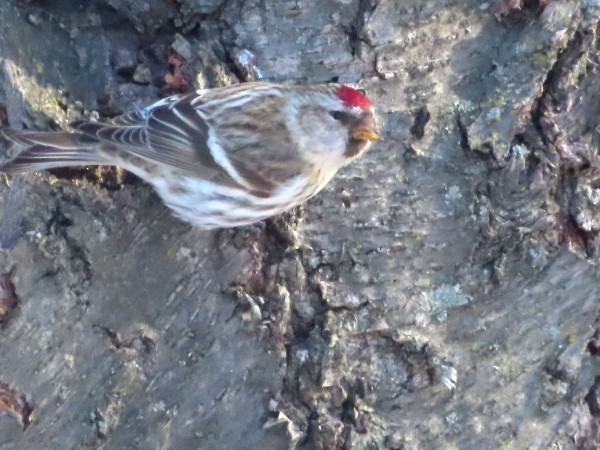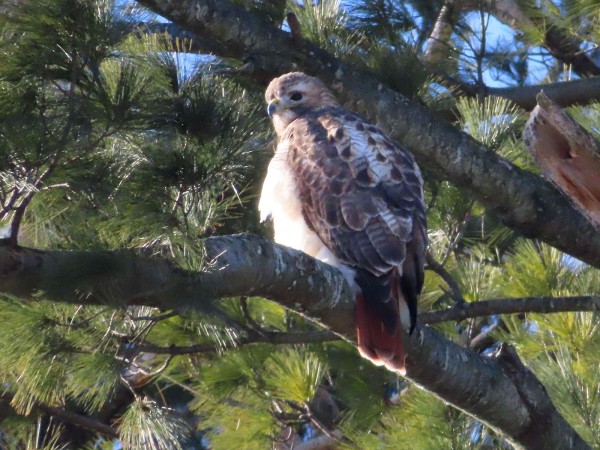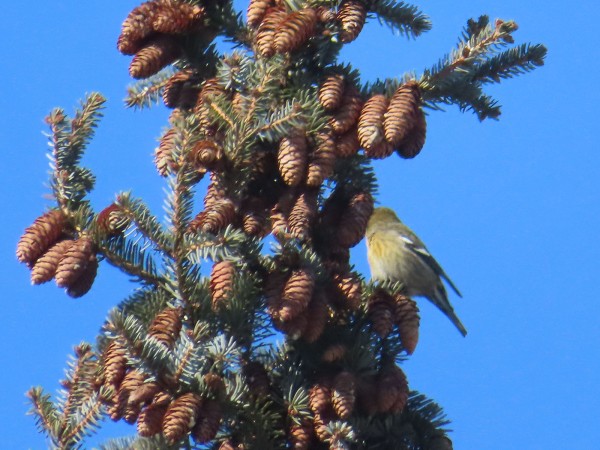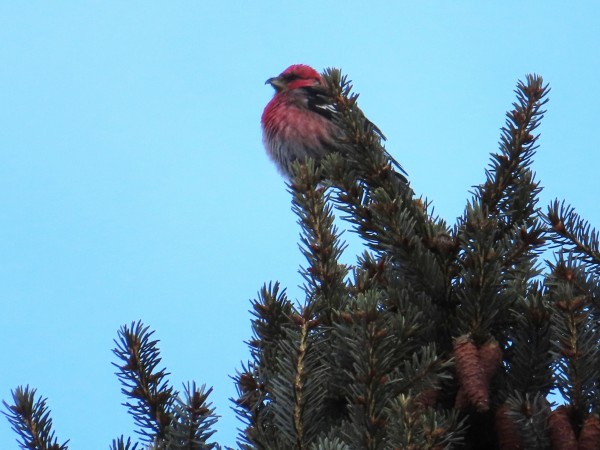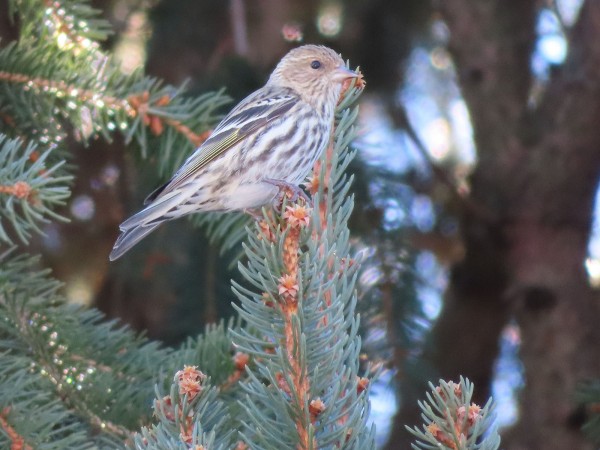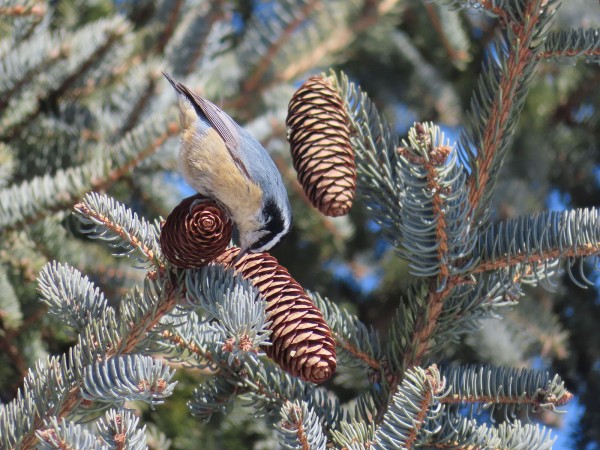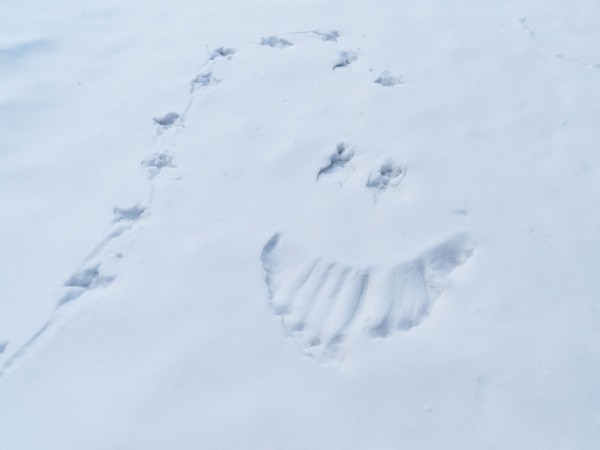Chuck's Birding Report #102
22 February - 28 February 2022
Dear fellow flock of birders,
The activity of the birds and the number of different species has not changed that much recently but now that we are moving into March we should begin to see a couple of early spring arrivals. It’s time to keep an eye and ear out for these new species.
My walks in the Arboretum over the last few weeks have followed the same pattern.
I start by checking out the White Spire Birches and the Sweet Birches on the south side of the Crabapple Collection. I look mainly for Common Redpolls eating seeds from the female catkins. First I look up into the trees for the birds. If they are not up in the trees I next look on the ground under the trees. Many of the seeds fall to the ground making it easy for the Redpolls to retrieve the seeds. A third place to look for the seeds is in the bark of the trunks of the trees. My first photo shows a Common Redpoll feeding on seeds it finds caught in the bark of a Sweet Birch.
I next walk over to the stand of White Pines northeast of the Visitor Center. I stand at the northeast corner of the White Pines and look at the two tallest pines. The one on the left is the one that contains the Red-tailed Hawk nest. If you start looking with your binoculars at the top and follow the trunk down about 20-30 feet you should be able to find the nest on the right side against the trunk. Sometimes there is no activity in the nest but today Hiam and I saw a Red-tailed Hawk carry a branch into the nest and weave it into its structure. We could at times see its head or its tail but never the whole hawk. Check out the nest on each of your visits to the Arb to see what’s happening at the nest. Included is a photo of one of the Red-tails perched not far from the nest.
From there I climb the hill to the many pine trees at the top of the hill. This area is called the Pinetum. Here I look for three species: the Red-breasted Nuthatch, the Pine Siskin and the rare White-winged Crossbill. Yesterday on Sunday I hit the jackpot. As I approached the pines at the top I saw about three fast moving, small birds. I was able to get my bins on one of them for just a few seconds and determined it was a Pine Siskin. They were really hard to follow but they fed on pine cone seeds momentarily and then would move to another pine to do the same thing. After a few minutes they flew away and all was quiet. I went looking for the Red-breasted Nuthatches but did not see or hear them. All of a sudden a flock of larger birds landed at the top of a Spruce with many pine cones near the top. Could it be a flock of White-winged Crossbills? Sure enough it was. I had not seen them for almost two months and now a flock of 8 had arrived. They too moved from tree to tree eating seeds from the pine cones. I followed them and took as many photos as I could. They stayed only 7-8 minutes and then left. Again I went looking for the Red-breasted Nuthatches. About that time Paul Rasmussen came walking up the hill. I told him he was 5-10 minutes late to see the Crossbills. I’ve heard that line myself many times in reference to seeing the Crossbills. We did see 4 Pine Siskins and shortly thereafter 3 or 4 Red-breasted Nuthatches. The latter were feeding both in the trees and on the ground. Included are two photos of White-winged Crossbills. The pinkish Crossbill is the male and the yellow/gray Crossbill is the female. Also included are a photo of a Pine Siskin and a photo of a Red-breasted Nuthatch.
From the Pinetum I usually cross the road and take the path down to the Big Spring. As I approach I look on the left and right sides of the far end of the spring outflow for the Great Blue Heron standing in the water partially hiding behind some overhanging branches. Most of the time it is there but recently I have not seen it for several days. I hope it’s okay. It’s my buddy. Also in the outflow are various numbers of Mallards and Gadwalls. Occasionally a Belted Kingfisher flies in and demonstrates its prowess at catching and swallowing fish. A couple days ago a male Mallard was off to the side in some very still water. I could see the Mallard and its various colors well. I could also see a well formed reflection in the quiet water. A photo is included.
From the Big Spring I usually stand trying to decide which way to go next depending on my energy level or enthusiasm or how cold or warm it is. Today Hiam and I walked to Skunk Cabbage Bridge and onto Arboretum Drive. From there we entered Gallistel Woods and went to Icke Boardwalk. I always look for Redpolls there but today there were none to be found.Instead Hiam pointed out a beautiful male Northern Cardinal singing at the top of a tree. For several weeks now many birders have heard the cardinals singing. It’s such a welcome sound! Included is a photo of Hiam’s Northern Cardinal. That red plumage is so striking in the sun.
The other day as I returned to my car I checked the Red-tailed Hawk nest one more time. Nobody was home so I just walked on and went on the west side of the White Pines. This was the day after it had dropped about 3 to 4 inches of soft, fluffy snow. As I continued my walk I came upon an interesting imprint in the snow. It was the impression of a Wild Turkey landing in the snow after sleeping overnight perched high in the White Pines. The impression included its fanned tail feathers, a hard landing with its feet and then several footprints as it walked away. Looking at the imprint again and tilting my head a bit I could also see the outline of a head, two eyes and a big toothy grin. There goes my imagination again. A photo of this snowy impression is included.
I’m rooting for an early spring. What about all of you out there?
That’s the Arboretum bird report for the past week.
I wish all of you good health and good birding in 2022,
Chuck

